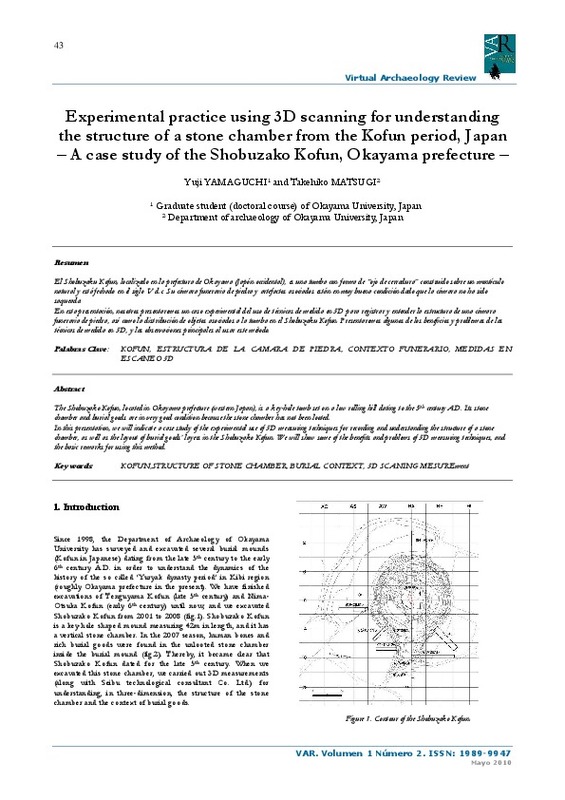JavaScript is disabled for your browser. Some features of this site may not work without it.
Buscar en RiuNet
Listar
Mi cuenta
Estadísticas
Ayuda RiuNet
Admin. UPV
Experimental practice using 3D scanning for understanding the structure of a stone chamber from the Kofun period, Japan – A case study of the Shobuzako Kofun, Okayama prefecture –
Mostrar el registro sencillo del ítem
Ficheros en el ítem
| dc.contributor.author | Yamaguchi, Yuji
|
es_ES |
| dc.contributor.author | Matsugi, Takehiko
|
es_ES |
| dc.coverage.spatial | east=133.6375314; north=34.8963407; name=Japó, Okayama, | es_ES |
| dc.date.accessioned | 2020-03-26T13:18:14Z | |
| dc.date.available | 2020-03-26T13:18:14Z | |
| dc.date.issued | 2010-05-25 | |
| dc.identifier.uri | http://hdl.handle.net/10251/139574 | |
| dc.description.abstract | [EN] The Shobuzako Kofun, located in Okayama prefecture (western Japan), is a key-hole tomb set on a low rolling hill dating to the 5th century AD. Its stone chamber and burial goods are in very good condition because the stone chamber has not been looted.In this presentation, we will indicate a case study of the experimental use of 3D measuring techniques for recording and understanding the structure of a stone chamber, as well as the layout of burial goods’ layers in the Shobuzako Kofun. We will show some of the benefits and problems of 3D measuring techniques, and the basic remarks for using this method. | es_ES |
| dc.description.abstract | [ES] El Shobuzaku Kofun, localizado en la prefectura de Okayama (Japón occidental), es una tumba con forma de “ojo de cerradura” construido sobre un montículo natural y está fechado en el siglo V d.c. Su cámara funeraria de piedra y artefactos asociados están en muy buena condición dado que la cámara no ha sido saqueada.En esta presentación, nosotros presentaremos un caso experimental del uso de técnicas de medida en 3D para registrar y entender la estructura de una cámara funeraria de piedra, así como la distribución de objetos asociados a la tumba en el Shobuzaku Kofun. Presentaremos algunos de los beneficios y problemas de las técnicas de medida en 3D, y las observaciones principales al usar este método. | es_ES |
| dc.language | Inglés | es_ES |
| dc.publisher | Universitat Politècnica de València | es_ES |
| dc.relation.ispartof | Virtual Archaeology Review | es_ES |
| dc.rights | Reconocimiento - No comercial - Sin obra derivada (by-nc-nd) | es_ES |
| dc.subject | Kofun | es_ES |
| dc.subject | Structure of stone chamber | es_ES |
| dc.subject | Burial context | es_ES |
| dc.subject | 3D scaning mesurement | es_ES |
| dc.subject | Estructura de la cámara de piedra | es_ES |
| dc.subject | Contexto funerario | es_ES |
| dc.subject | Medidas en escaneo 3D | es_ES |
| dc.title | Experimental practice using 3D scanning for understanding the structure of a stone chamber from the Kofun period, Japan – A case study of the Shobuzako Kofun, Okayama prefecture – | es_ES |
| dc.type | Artículo | es_ES |
| dc.identifier.doi | 10.4995/var.2010.4684 | |
| dc.rights.accessRights | Abierto | es_ES |
| dc.description.bibliographicCitation | Yamaguchi, Y.; Matsugi, T. (2010). Experimental practice using 3D scanning for understanding the structure of a stone chamber from the Kofun period, Japan – A case study of the Shobuzako Kofun, Okayama prefecture –. Virtual Archaeology Review. 1(2):43-46. https://doi.org/10.4995/var.2010.4684 | es_ES |
| dc.description.accrualMethod | OJS | es_ES |
| dc.relation.publisherversion | https://doi.org/10.4995/var.2010.4684 | es_ES |
| dc.description.upvformatpinicio | 43 | es_ES |
| dc.description.upvformatpfin | 46 | es_ES |
| dc.type.version | info:eu-repo/semantics/publishedVersion | es_ES |
| dc.description.volume | 1 | es_ES |
| dc.description.issue | 2 | es_ES |
| dc.identifier.eissn | 1989-9947 | |
| dc.relation.pasarela | OJS\4684 | es_ES |
| dc.description.references | Archaeological Institute of Kashihara, Nara Prefecture (2005): Sanjigen Dejitaru Akaibu wo Katsuyou-Shita Kokyou no Sougouteki Kenkyu (A general study of old mirrors by three-dimensional digital archive technology), Bulletin of the Archaeological Institute of Kashihara, Vol.8. | es_ES |
| dc.description.references | BESSHO Hidetaka and MATSUGI Takehiko (2008): "Material source of stone chamber elements and the burial mound of the Shobuzako Kofun, Okayama Prefecture, western Japan (abstract)", in WAC6, Ireland 2008, Sixth World Archaeological Congress (proglam). Dublin. | es_ES |
| dc.description.references | MATSUGI Takehiko (ed.) (2001): Kibi Chiiki ni Okeru "Yuryaku-Cho" Ki no Kokogaku-teki Kenkyu (Archaeological research into the Yuryakudynasty period in Kibi Region): Kagaku Kekyui Hojokin (Kiban Kenkyu(B)(2)) Kenkyu Seika Hokokusho, Heisei 9 Nendo -Heisei 12 Nendo, Okayama. | es_ES |
| dc.description.references | MATSUGI Takehiko (ed.) (2008): Mitokutsu Kofun no Hakkutsu Chosa, Shobuzako Kofun Dai 5 Ji Hakkutsu Chosa (Shobuzako tumulus excavation report 1-5th excavation, 2001-2005 Okayama, Japan.), Faculty of Letters, Okayama University. | es_ES |
| dc.description.references | NIIRO Izumi (ed) (2008): Okayama-shi Zozan Kofun Sokuryo Chosa Gaihou (A preliminary report of Zozan Kofun, Okayama city, Okayama prefecture, Japan), Kagaku Kekyui Hojokin Kiban Kenkyu(B) Kenkyu Seika Hokokusho. | es_ES |
| dc.description.references | OKSBERG, Jane (2007): "The Last Excavation at Shobuzako Kofun.", in Bulletin of the Society for East Asian Archaeology ,Vol.1, the Society for East Asian Archaeology, pp.35-48. | es_ES |
| dc.description.references | SEIKE Akira (ed.) (2006): Nankoku-shi ni Okeru Ogata Koki Kofun no Chosa. (The investigations of large-scaled Late Kofun in Nankoku city, Kochi Prefectue, Japan.), Kochi Daigaku Kokogaku Kenkyushitsu. | es_ES |








